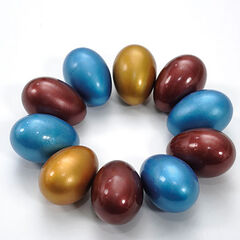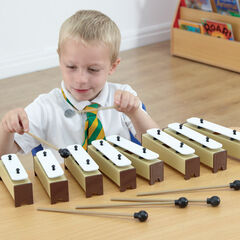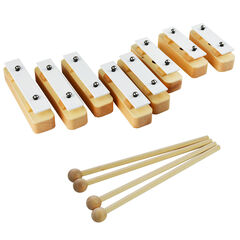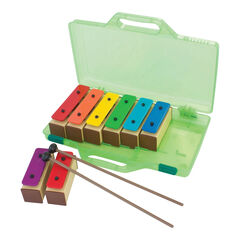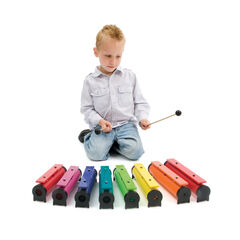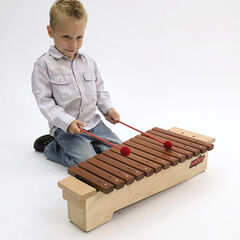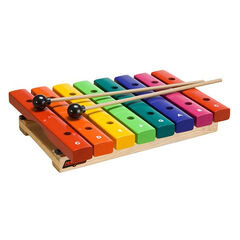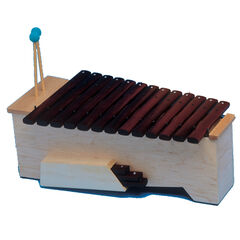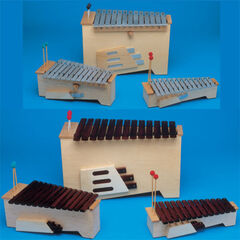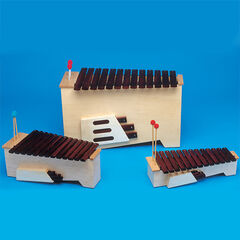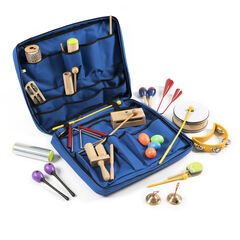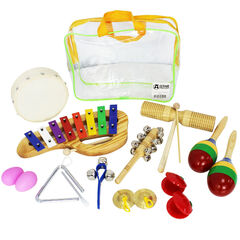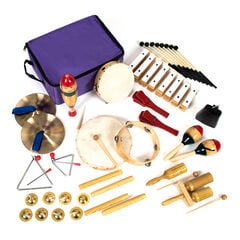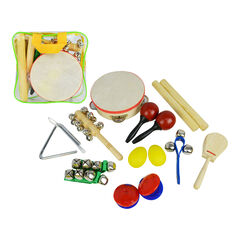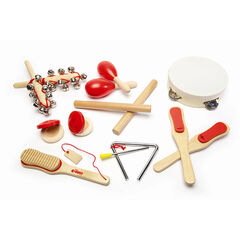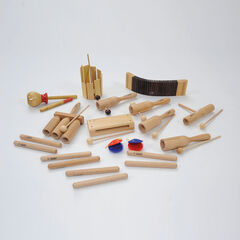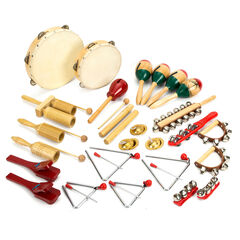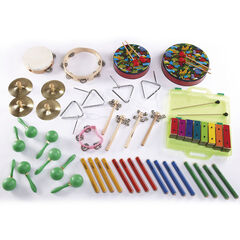Teaching pulse, rhythm and pitch to primary school children is vital. They are the nuts and bolts that make up music. The benefits of having these secure in music teaching in Early Years (EYFS) and early Key Stage 1 makes teaching music in Key Stage 2 much easier.
In this blog, we will explore fun and engaging activities for teaching pulse, rhythm, and pitch, helping you create a comprehensive and enjoyable musical learning experience for children.
Pulse

The pulse is the heartbeat of the music, it’s what you tap your foot or move to. It is usually constant, like the ticking of a clock (not always at that speed!). Simple songs and music have a constant pulse from beginning to end, but it is also usual for music to have a change of pulse within the music – getting gradually faster or slower to add interest. Every song or piece of music will have a unique speed (tempo) and depending on where the ‘strong’ beat falls, a different feel too (waltz, march, ballad etc.).
The National Curriculum for Music suggests that we need to teach children to play instruments musically. The ability to feel a pulse is the answer to this part of the curriculum.
Activity 1 (Teaching Pulse)
Foundation, KS1 and KS2
When singing a song, listening to a piece of music or chanting a rhyme, tap the pulse. You can do this on your legs or other parts of the body where little or no noise will be created. Remember you’re finding the heartbeat of the music!
Decide – is the pulse fast or slow?
Can the whole class do the following:
Tap the pulse at exactly the same time?
Change the speed of the pulse, making the song faster or slower?
Tap the pulse on different parts of the body?
Talk at the speed of the pulse (you need a good pace for this)?
Activity 1 (Teaching Pulse)
Foundation, KS1 and KS2
When singing a song, listening to a piece of music or chanting a rhyme, tap the pulse. You can do this on your legs or other parts of the body where little or no noise will be created. Remember you’re finding the heartbeat of the music!
Decide – is the pulse fast or slow?
Can the whole class do the following:
Tap the pulse at exactly the same time?
Change the speed of the pulse, making the song faster or slower?
Tap the pulse on different parts of the body?
Talk at the speed of the pulse (you need a good pace for this)?
Activity 2 (Teaching Pulse)
Foundation, KS1 and KS2
You will need: Egg shakers or similar; DaCapo Heartbeats
Every child has an egg shaker (or similar quiet instrument) – if this is not possible, give as many eggs as you have and give everyone else a Heartbeat – then we need to swap!
Singing a song that the class enjoy and know well, shake the shakers in time to the beat – steady and constant.
The challenge is to start together and stop together.
Can we do this activity and change the speed of the pulse, making the song faster or slower and stay together?
Tip – to start the singing, think of the speed of the song and sing “ready to sing” at the speed you want to sing the song.
Activity 3 (Teaching Pulse)
Key Stage 2
You will need: A good quality ball that bounces well – and a large space.
Stand the children in a circle.
Bounce the ball across the circle to another member of the class and say your own name as it hits the floor.
The child who catches the ball then does the same.
Can the children bounce the ball:
At the same speed all the time and keep going?
More slowly and still maintaining a pulse?
Faster and maintaining the pulse?
Variation
Bounce the ball across the circle and say the name of the person you’re expecting to catch it.
Rhythm

Rhythm fits into a pulse and can often be identified by the syllables of a song. If you clap the words/syllables, you will probably be clapping the rhythms. These are identified by different names, depending on the system you choose:
- American – whole note, half note, quarter note etc.
- British – semibreve, minim, crotchet etc.
- Kodály – taaa, taa ta, titi etc.
The National Curriculum for Music asks us to teach children to “use their voices expressively and creatively by singing songs and speaking chants and rhymes”. Ensuring that we sing and clap the words of the rhymes and songs will ensure that this is done.
Activity 1 (Teaching Rhythm)
Foundation, KS1 and KS2
Finding the rhythms of your name.
Sitting in a circle, take it in turns to say and clap the names of all of the children in turn.
To make it a more musical activity preface the name with “Hello”, so that all the children are clapping the name and benefitting from the activity and not only one child at a time.
e.g. “Hello Sophie” – this has 4 claps (ta ta ta ta);
“Hello Ben” – this has three taps and a gap (ta ta ta z);
“Hello Isata” – this has 5 claps (ta titi ta ta).
Try to clap with the rhythm or emphasise the rhythm when you say the name Isata – the emphasis is on the second syllable.
Activity 2 (Teaching Rhythm)
Foundation, KS1 and KS2
Finding the rhythm in a song.
Sing a song that the class enjoy and know well and clap the words.
Make sure that each syllable is articulated.
Do this with as many songs as you can, and notice the ones that are easy and those that are more difficult.
Repetition and having the teacher as the example will help the children get this accurate.
More Advanced (KS1 and 2)
Singing a song that the class enjoy and know well, use a very precise percussion instrument, such as claves or frog guiro to tap the words.
Encourage the children to check that what they are clapping is what they are singing.
Are we clapping the same thing?
Singing a song that the class enjoy and know well, get one half of the class to maintain the pulse, either with heart beats or egg shakers etc., and the other group to clap or play the words of the song on the claves.
This will help cement the understanding of the difference between words and heartbeat/pulse and rhythm. It takes time and many attempts.
Activity 3 (Teaching Rhythm)
Key Stage 1 and 2
Forbidden Rhythm.
Walking in a circle, ensure that we are all working at the same speed and that our feet are making the pulse all together (ta ta ta ta etc).
The leader (teacher or pupil) claps rhythm patterns in time to the pulse and the class clap the patterns back:
e.g. Leader – ta ta titi ta – Class – ta ta titi ta – Leader titi ta titi ta – Class titi ta titi ta
Do at least six of these.
Choose a rhythm pattern that the leader will clap but that the class is forbidden to clap back.
e.g. Forbidden rhythm pattern titi titi titi ta
e.g. Leader – ta ta titi ta – Class ta ta titi ta – Leader titi ta titi ta – Class titi ta titi ta – Leader – titi titi titi ta – Class – keep walking to the pulse and do not clap back.
Pitch

Pitch is the word we use to describe the higher or lower notes. A flute is high pitched and a double bass low pitched. There are different degrees of pitch within a song. These are either identified by letter names (C D E F G A B etc.) or solfa names (do re mi fa so la ti).
The National Curriculum asks us to teach children to “play tuned and untuned instruments musically”. Focussing on how we use our voices and linking songs to the instruments that we use enables us to do this.
Activity 1 (Teaching Pitch)
Foundation, KS1 and KS2
Finding our voice.
Using this call and response rhythm , encourage children to find different sounds in their voice. Make sure the rhythm has a strong pulse and the words are very rhythmic.
Leader – spoken: “Have you got your speaking voice?”
Children – spoken: “Yes, we have.”
Leader – whispered: “Have you got your whispering voice?”
Children – whispered: “Yes, we have.”
Leader – with a croaky voice: “Have you got your croaky voice?”
Children – with a croaky voice: “Yes, we have.”
Add as many variations as you like and end with….
Leader – shouted: “Have you got your shouting voice?”
Children – shouting: “Yes, we have.” (perfectly in time?)
Leader – sung on two notes: F and D (Find a tuned instrument, such as chime bars or xylophone, to help find these notes) – “Have you got your singing voice?”
Children – sung: “Yes, we have.”
NB – the benefit of shouting in a rhyme ensures that we build control, we know the difference between shouting and singing loudly!
Activity 2 (Teaching Pitch)
Foundation, KS1 and KS2
Find the starting note of a song and start singing together.
Singing a song that the class enjoy and know well, start by singing “ready to sing” at the speed that you want the song to go at and on one note.
You can use a xylophone to help you or just trust that your voice will find a note that you’re comfortable with.
There may be children who want to sing, “Ready to sing.”
Listen to the class. Are we all singing the same thing or are there some children struggling to start the song on this note?
Each time you sing the song, try to sing “ready to sing” on a new note. This means you will be using a different part of your voice and sometimes it will be too high for some people and too low for some people! We all have different voices!
Activity 3 (Teaching Pitch)
Key Stage 1 and 2
Identify the notes that you are singing.
Choose a song with only a few notes (starting with 2 note songs (so mi/ f – d) is helpful).
Sing the song and ensure the whole class can sing it on those notes.
Use hand movements to show which note is the high one and which is the lower one (Kodály hand signs are useful here).
Using a xylophone or chime bars, identify those two notes and play the song on the instrument(s). Singing with the letter names (f – d) or relative solfa (so mi) if you’re using Kodály.
You can read about the Kodály method here: www.dacapo.co.uk/the-kodaly-approach/
Useful Resources:
In conclusion, teaching pulse, rhythm, and pitch to primary school children is a fun and crucial part of their musical development. By using engaging methods, educators can inspire a lifelong love of music, laying the groundwork for a deeper appreciation and understanding that will last a lifetime.

With thanks to Jane Cutler and Michelle Groves for sharing this blog.

Jane Cutler
Jane is the musical founder of the DaCapo Music Foundation. Together with Michelle Groves, she has been researching and testing the DaCapo approach to musical education with children for over twenty five years, fine-tuning the best methods, approaches and resources needed for an effective music education.
Jane trained as a cellist at Trinity College of Music. In 1986 she began to work within the famous Tower Hamlets Strings Project, where she came into contact with both the Kodaly method and the Dalcroze method. Here, she also had the opportunity to work alongside some of the most inspirational teachers of the time. She went on to study the Kodaly method for three years at the Kodaly Centre of London (David Vinden).
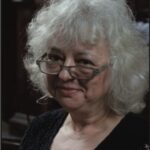
MIchelle Groves
Michelle met Jane Cutler in the late 1980s when Jane taught her daughters. She was inspired by Jane’s ideas and together they decided to establish DaCapo, with a growing determination to make a different in musical education.
Over the last 30 years, Michelle has guided DaCapo’s growth from a local organisation into one which both delivers and influences music teaching in many different settings, across the UK and overseas.


